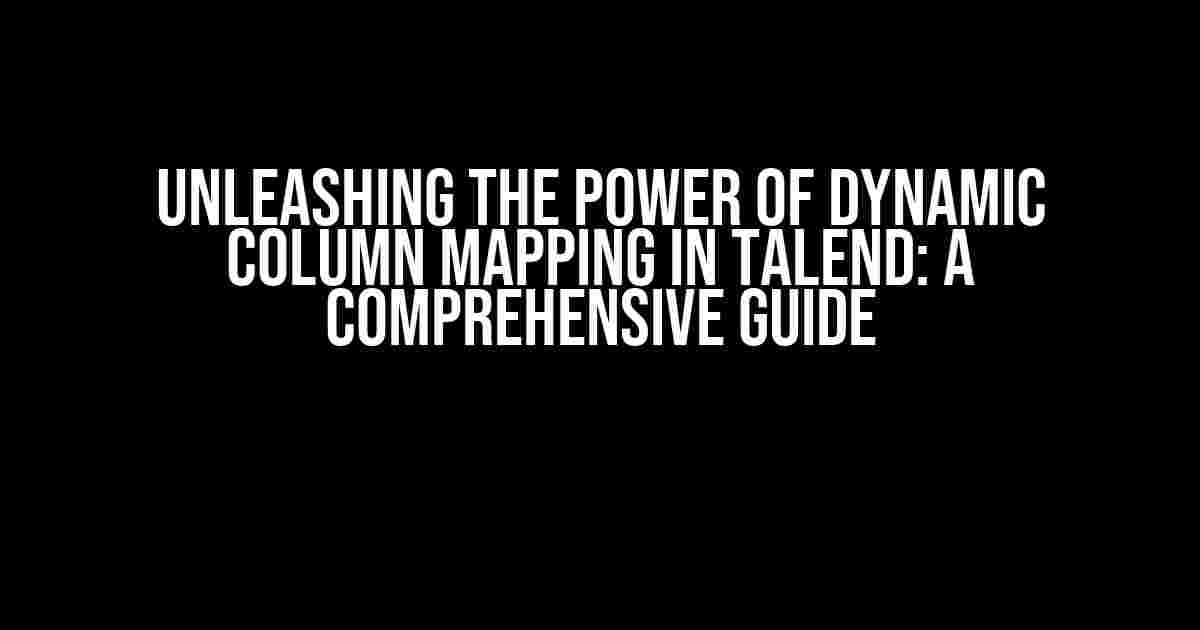Are you tired of manually mapping columns in your data integrations? Do you struggle with handling complex data structures and varying column counts? Look no further! Dynamic Column Mapping in Talend is here to revolutionize the way you approach data integration. In this article, we’ll dive deep into the world of Dynamic Column Mapping, exploring its benefits, implementation, and best practices.
What is Dynamic Column Mapping in Talend?
Dynamic Column Mapping is a powerful feature in Talend that allows you to dynamically map columns between different data sources and targets. This means you can automatically adapt to changes in your data structure, eliminating manual mapping and reducing the risk of errors.
Benefits of Dynamic Column Mapping
- Flexibility**: Handle changing data structures with ease, without needing to modify your mapping configurations.
- Efficiency**: Automate column mapping, reducing the time and effort required for manual mapping.
- Accuracy**: Minimize errors caused by manual mapping, ensuring data integrity and consistency.
- Scalability**: Dynamic Column Mapping makes it easy to handle large datasets with varying column counts.
Implementing Dynamic Column Mapping in Talend
To get started with Dynamic Column Mapping in Talend, follow these step-by-step instructions:
- Create a new Talend job**: Launch Talend and create a new job by selecting “File” > “New” > “Job”. Choose a name for your job and select “OK”.
- Drag and drop components**: In the Talend workspace, drag and drop the components required for your data integration, such as tCsvInput, tMap, and tLogRow.
- Configure the input component**: Configure the input component (e.g., tCsvInput) to read data from your source file. Make sure to select the correct delimiter and encoding.
- Enable Dynamic Column Mapping**: In the input component, click on the “Advanced settings” button and select “Dynamic column mapping”. This will enable Talend to automatically detect and map columns.
- Configure the tMap component**: In the tMap component, create a new output schema by clicking on the “New” button. Select “Dynamic” as the schema type.
- Map columns dynamically**: In the tMap component, drag and drop the input columns to the output schema. Talend will automatically map the columns based on their names and data types.
- Run the job**: Save and run the job to see Dynamic Column Mapping in action.
Dynamic Column Mapping in Action
| Input Columns | Output Columns |
|---|---|
| id | id |
| name | full_name |
| age | age |
| city | location |
In this example, the input columns “id”, “name”, “age”, and “city” are dynamically mapped to the output columns “id”, “full_name”, “age”, and “location” respectively.
Best Practices for Dynamic Column Mapping
Use Meaningful Column NamesUsing meaningful and descriptive column names helps Talend to accurately map columns. Avoid using generic names like “Column1”, “Column2”, etc.
Handle Null Values
Null values can cause issues with Dynamic Column Mapping. Make sure to handle null values correctly by using the “Null” value in the tMap component.
Test andValidate
Thoroughly test and validate your Dynamic Column Mapping configuration to ensure accurate results.
Document Your Configuration
Document your Dynamic Column Mapping configuration and best practices for future reference and maintenance.
Common Issues and Solutions
Conclusion
Dynamic Column Mapping in Talend is a game-changer for data integration. By following the instructions and best practices outlined in this article, you’ll be able to harness the power of Dynamic Column Mapping to simplify your data integrations, reduce errors, and increase efficiency.
Note: This article is for educational purposes only and is not affiliated with Talend or its official documentation.
Get started with Dynamic Column Mapping in Talend today and take your data integration to the next level!
Frequently Asked Questions
Get ready to unlock the power of Dynamic Column Mapping in Talend with these frequently asked questions!
What is Dynamic Column Mapping in Talend?
Dynamic Column Mapping in Talend is a powerful feature that allows you to map your data columns dynamically, without the need to manually specify the column names. This feature is especially useful when working with large datasets or data sources with varying column structures.
How does Dynamic Column Mapping work in Talend?
Dynamic Column Mapping in Talend works by using a mapping table that stores the column names and their corresponding data types. During runtime, Talend dynamically maps the incoming data to the correct columns based on the mapping table, without the need for manual intervention.
What are the benefits of using Dynamic Column Mapping in Talend?
The benefits of using Dynamic Column Mapping in Talend include improved data integrity, reduced development time, and increased flexibility. It also allows for easier maintenance and updates, as changes to the data source or target schema can be easily accommodated without modifying the Talend job.
How do I implement Dynamic Column Mapping in Talend?
To implement Dynamic Column Mapping in Talend, you can follow these steps: create a mapping table that stores the column names and data types, configure the Talend job to use the mapping table, and then execute the job to dynamically map the data columns.
Is Dynamic Column Mapping in Talend compatible with all data sources and targets?
Dynamic Column Mapping in Talend is compatible with most data sources and targets, including databases, flat files, and cloud-based storage systems. However, it’s essential to verify compatibility with specific data sources and targets before implementing Dynamic Column Mapping in your Talend job.
I hope these FAQs have helped you unlock the power of Dynamic Column Mapping in Talend!
